
“India happens to be currently the third-largest tobacco producing nation and the second-largest consumer of tobacco worldwide. The latest survey data published by the World Health Organisation specifies around 266.8 million current tobacco users.”
As the entire world tries to tackle the carnage of a severe pandemic, tobacco consumption, which exacerbates the susceptible population’s health conditions, continues to be one of the prime threats to public health. The adverse effects seem to do more harm in low- and middle-income nations. Paradoxically, tobacco consumption presents itself as an avoidable vice. Glaringly, India is home to over 11% of the world’s cigarette smokers.
The World Health Organisation (WHO) approximates around 1.1 billion smokers worldwide and envisages about 1 billion premature smoking-related deaths during the 21st century, till date. Unfortunately, a complicated public health environment characterises the Indian diaspora, given many smokers and convolutions from tobacco usage in diversified forms. India happens to be currently the third-largest tobacco producing nation and the second-largest consumer of tobacco worldwide. The latest survey data published by the World Health Organisation specifies around 266.8 million current tobacco users.
The rise in tobacco cessation initiatives was emphasised on World No Tobacco Day, 2021. It is worth mentioning WHO’s Quit challenge chatbot available on WhatsApp and Facebook, which aids in encouraging people to remain tobacco-free by frequent notifications for up to 6 months. As a part of the campaign, WHO has quoted “Quitters” as the “real winners in the case of tobacco”.
“tobacco has aggravated the high burden of tuberculosis and Multi-Drug Resistant (MDR) tuberculosis times in India.”
Tobacco Usage in India- A Descriptive Picture:
Notably, tobacco use in India is generally attributable to the use of (i) smoking tobacco in its alternative form like bidis, chillum, shisha, water pipes, hookahs and so on. (ii) chewing or Smokeless Tobacco (SLT) like betel quid with tobacco, khaini, tobacco lime mixture, gutka, oral tobacco, pan masala, snuff (iii) combination of smokeless and chewing tobacco. Dismally tobacco-related deaths in India are estimated to be over 1 million. One of the immediate negative impacts of tobacco consumption is oral cancer. Resultantly, around five people in India die every hour due to the mentioned morbidity. It is easy to acknowledge that tobacco-related mortality in India is mainly linked to the high incidence of oral cancer. Incidentally, tobacco has aggravated the high burden of tuberculosis and Multi-Drug Resistant (MDR) tuberculosis times in India.
Data and Revelations:
Adhering to the urgent need for stern intervention to diminish the prevalence of smoking among the masses, the Government of India has taken note of the tobacco epidemic and followed up through the instigation of numerous actions. Realising the importance of data-driven analysis in the modern world, the Government of India has acted as a vanguard to take up the global tobacco surveys. The Global Adult Tobacco Survey (GATS), which intended to yield internationally comparable data on tobacco use, has established itself as a primary tool for monitoring adult tobacco use and investigating the key tobacco control indicators. The first round of GATS was carried out in 2009-10, whereas the second round was implemented in 2016-17.
GATS 2 proved to be a plethora of revelations. It was noted that around 28.6% of adults in India aged 15 and above actively used tobacco in some form. Among the adults, 1/4th of the population accounted for daily tobacco users, and every tenth adult in India was associated with smoking. The prevalence of tobacco used was conveyed across the states/Union Territories, with Tripura and Goa being at the two extremes. Khaini and bidi were allegedly the most commonly used tobacco products among men.
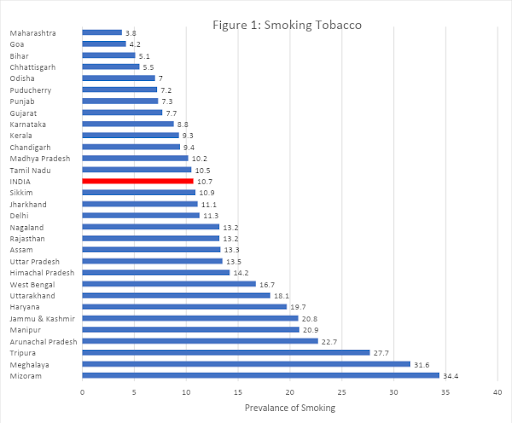
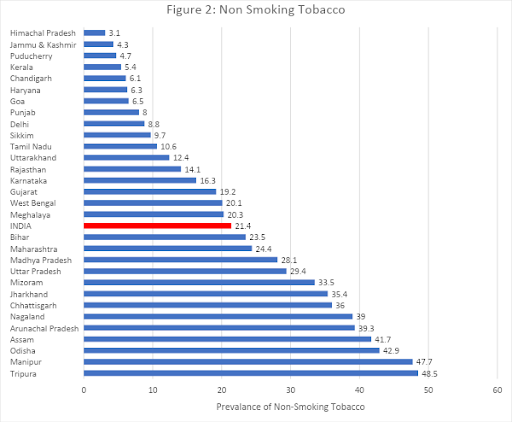
A remarkable variance was observed during the comparison of the pervasiveness of tobacco usage through the results of GATS 1 and GATS 2. As can be observed from Figure 3, the prevalence of current tobacco users (both smokers and smokeless tobacco users) in India had lessened admirably from 2009-10 to 2016-17. This was mainly due to the ramped-up action by the government leading to the increased promotion of health warnings on packages of cigarette, bidi and smokeless tobacco during the period mentioned above.
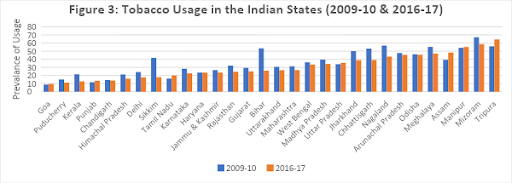
“The government has also ramped up its message against smoking through pictorial health warning labels on tobacco products. The sale of tobacco products via vending machines and within 100 yards of any educational institution is also forbidden in India.”
Government Policies to Fight Tobacco in India:
In pursuit of eliminating the impropriety of tobacco smoking among the masses, India became a Party to the WHO Framework Convention on Tobacco Control in February 2005. Accordingly, several practises are adhered to bring down the prevalence of smoking.
Smoking is prohibited in several public places and workplaces, including public transport. Advertising through a majority of mass media is entirely restricted. The government has also ramped up its message against smoking through pictorial health warning labels on tobacco products. The sale of tobacco products via vending machines and within 100 yards of any educational institution is also forbidden in India. Lastly, the production, manufacture, import, export and advertising of e-cigarettes is banned in this nation. To fight for the noble cause, the digitally centre has set up a national-level helpline- Quitline (1800-112-356) for those seeking aid to quit any form of tobacco use. A roadmap of all government policies implemented in this venture to date is provided below.
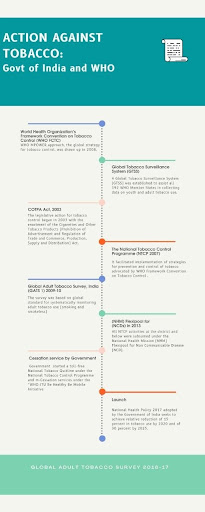
Smoking 19, Covid and Cessation:
According to the UN health agency, the finding that smokers were more likely to develop severe disease with COVID-19 than non-smokers triggered millions of people to want to quit tobacco. However, without adequate support, withdrawing can be incredibly challenging. As the risks associated with incidence and resultant fatalities from the lethal COVID-19 continues to terrorise the masses, a significant chunk of the tobacco users (especially smokers) has reportedly adopted for cessation of their malpractices. Fatalities arising out of COVID-19 are often casually linked to a history of smoking.
The survey of GATS-2 (2016-17) had then delved deep into the issue and scrutinised the duration of tobacco cessation across various categories. The following pie charts are graphical analysis of the results obtained:
As is evident from the data shown, parallel to the efforts put in by the government, the expected mass has come a long way to give up this social vice. The data, which is symbolic of the picture prevailing in 2016, suggests that the consternation caused by Covid-19 has only improved these numbers. Although Quitting can be challenging, especially with the added social and economic stress that has come as a result of the pandemic. Interestingly it was found that every 3rd smoker and smokeless tobacco consumer had attempted to quit tobacco use in the past 12 months, which is an indisputably noteworthy feat.
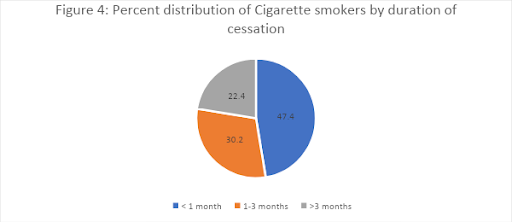
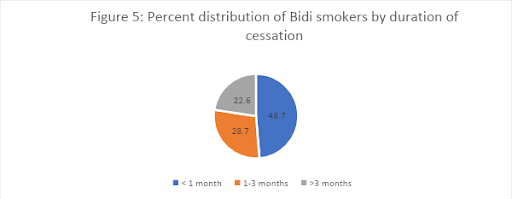
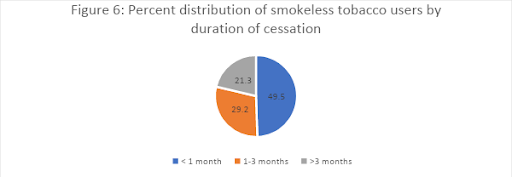
A survey for charity Action on Smoking and Health (Ash) stated that more than a million people had given up smoking since the deadly pandemic outbreak. Actual figures from India in this context are not available yet. However, even during the pre-COVID times, attempts to cease tobacco consumption (both smoking and smokeless) were observed profoundly.
Despite the plummeting numbers in the pervasiveness of smoking in this nation, there must not be any slack in the attempt to control tobacco use. Given the disparities in variations in tobacco use prevalence across the states, a comprehensive, evidence-based implementation plan is the need of the hour. Mass awareness programmes, expansion of outreach of existing cessation support programmes and anti-tobacco warnings need to be continued in full flow to make the nation tobacco-free shortly.
“Saptorshi Gupta is an M.Sc. student at the International Institute for Population Sciences. His research interest includes public health, development economics and epidemiology.”
“Pooja Verma is an M.Sc. student at the International Institute for Population Sciences. Her research interest include public health, migration and development policy.”

